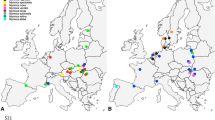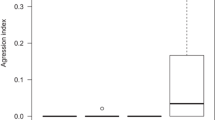Abstract
The arms race between Maculinea butterflies and Myrmica host ants leads to local host-parasite adaptations. In our study, we assessed whether sympatric and allopatric Myrmica scabrinodis populations exhibit behavioural differences towards Maculinea teleius larvae during the adoption-period when butterfly larvae need to be taken inside the Myrmica nest. The second aim was to assess the butterfly survival rate inside ant colonies from different populations. We used one sympatric host population and three allopatric populations: one infested by M. teleius and two uninfested populations. We found that ants from the sympatric population showed a higher number of positive behaviours toward M. teleius larvae during adoption than ants from the allopatric populations. There were no differences in the number of inspection or negative behaviour events. The survival of butterfly larvae was highest inside sympatric host colonies and differed from the survival of M. teleius reared by ants from the allopatric, uninfested populations. No difference was found for the survival rate of M. teleius raised by infested, allopatric host colonies compared to sympatric host populations. Our results suggest the lack of behavioural counter-adaptations of local hosts of M. teleius that more easily adopt and rear butterfly caterpillars compared to naive M. scabrinodis colonies. Our results may also have implications for Maculinea butterfly conservation, especially for reintroduction programmes. We suggest that the existence of behavioural host defences should be checked for the source host population, as well as for the Myrmica population from the reintroduction site. It may also be reasonable to introduce several Myrmica host colonies from the source butterfly host population.


Similar content being viewed by others
References
Akino T, Knapp JJ, Thomas JA, Elmes GW (1999) Chemical mimicry and host specificity in the butterfly Maculinea rebeli, a social parasite of Myrmica ant colonies. Proc R Soc Lond B 266:1419–1426
Als TD, Nash DR, Boomsma JJ (2001) Adoption of parasitic Maculinea alcon caterpillars (Lepidoptera: Lycaenidae) by three Myrmica ant species. Anim Behav 62:99–106
Andersen A, Simcox DJ, Thomas JA, Nash DR (2014) Assessing reintroduction schemes by compering genetic diversity of reintroduced and source populations: a case study of the globally threatened large blue butterfly (Maculinea arion). Biol Conserv 175:34–41
Barbero F, Casaccii LP (2015) Butterflies that trick ants with sound. Phys Today 68:64.
Bauer S, Witte V, Böhm M, Foitzik S (2009) Fight or flight? A geographic mosaic in host reaction and potency of a chemical weapon in the social parasite Harpagoxenus sublaevis. Behav Ecol Sociobiol 64:45–56
Buszko J (1997) Atlas rozmieszczenia motyli dziennych w Polsce (Lepidoptera: Papilionoidea, Hesperioidea) 1986–1995. Oficyna Wydawnicza Turpress, Toruń
Cammaerts-Tricot MC (1974) Production and perception of attractive pheromones by differently aged workers of Myrmica rubra (Hymenoptera: Formicidae). Insect Soc 3:235–248
Foitzik S, De Heer CJ, Hunjan DN, Herbers JM (2001) Coevolution in host-parasite system: behavioural strategies of slavemaking ants and their hosts. Proc R Soc Lond 268:1139–1146
Foitzik S, Fischer B, Heinze J (2003) Arms races between social parasites and their hosts: geographic patterns of manipulation and resistance. Behav Ecol 14:80–88
Hayes MP (2015) The biology and ecology of the large blue butterfly Phengaris (Maculinea) arion: a review. J Insect Conserv 19:1037–1051
Jongepier E, Kleeberg I, Job S, Foitzik S (2014) Collective defence portfolios of ant hosts shift with social parasite pressure. Proc R Soc B 281:20140225
Nash DR, Als TD, Maile R, Jones G, Boomsma JJ (2008) A mosaic of chemical coevolution in a large blue butterfly. Science 319:88–90
Nash DR, Als TD, Boomsma JJ (2011) Survival and growth of parasitic Maculinea alcon caterpillars (Lepidoptera, Lycaenidae) in laboratory nests of three Myrmica ant species. Insect Soc 58:391–401
Radchenko AG, Elmes GW (2010) Myrmica ants (Hymenoptera: Formicidae) of the old world. Natura Optima Dux Fundation, Warszawa
R Core Team (2015): R: A language and environment for statistical computing. R Foundation for Statistical Computing, Vienna. http://www.R-project.org/.
Schönrogge K, Wardlaw JC, Peters AJ, Everett S, Thomas JA, Elmes GW (2004) Changes in chemical signature and host specificity from larval retrieval to full social integration in the myrmecophilous butterfly Maculinea rebeli. J Chem Ecol 30:91–107
Sielezniew M, Stankiewicz-Fiedurek AM (2009) Host ant use by Phengaris (=Maculinea) alcon (Lepidoptera, Lycaenidae) in Poland. Pol J Entomol 78:323–335
Solazzo G, Mortiz RFA, Settele J (2013) Choice behaviour of Myrmica rubra workers between ant larvae and larvae of their Phengaris (Maculinea) nausithous nest parasites. Insect Soc 60:57–64
Stankiewicz A, Sielezniew M (2002) Host specificity of Maculinea teleius Bgstr. and M. nausithous Bgstr. (Lepidoptera: Lycaenidae). The new insight. Ann Zool 52:403–408
Tartally A. and Varga Z (2008) Host ant use of Maculinea teleius in the Carpathian basin (Lepidoptera: Lycaenidae). Acta Zool Acad Sci Hung 54:257–268
Tartally A, Nash DR, Lengyel S, Varga Z (2008) Patterns of host ant use by sympatric populations of M. alcon and M. rebeli in the Carpathian Basin. Insectes Soc 55:370–381
Therneau T (2015) A Package for Survival Analysis in S. version 2.38. http://CRAN.R-project.org/package=survival
Thomas JA (1980) Why did the large blue become extinct in Britain? Oryx 15:243–247
Thomas JA, Simcox DJ, Clarke RT (2009) Successful conservation of a threatened Maculinea butterfly. Science 325:80–83
Thompson JN (1999a) The evolution of species interactions. Science 284:2116–2118
Thompson JN (1999b) Specific hypotheses on the geographic mosaic of coevolution. Am Nat 153:1–14
Witek M, Śliwińska EB, Skórka P, Nowicki P, Wantuch M, Vrabec V, Settele J., Woyciechowski M (2008) Host ant specificity of large blue butterflies Phengaris (Maculinea) (Lepidoptera: Lycaenidae) inhabiting humid grassland in East-central Europe. Eur J Entomol 105:871–877
Witek M, Skórka P, Śliwinska BE, Nowicki P, Moroń D, Settele J, Woyciechowski M (2011) Development of parasitic Maculinea teleius (Lepidoptera: Lycaenidae) larvae in laboratory nests of four Myrmica ant host species. Insectes Soc 58: 403–411
Witek M, Casacci LP, Barbero F, Patricelli D, Sala M, Bossi S, Maffei M, Woyciechowski M, Baletto E, Bonelli S (2013) Interspecific relationships in co-occurring populations of social parasites and their host ants. Biol J Linn Soc 109:699–709
Witek M, Barbero F, Markó B (2014) Myrmica ants host highly diverse parasitic communities: from social parasites to microbes. Insectes Soc 61:307–323
Witek M, Ślipiński P, Naumiec K, Krupski A, Babik H, Walter B, Symonowicz B, Dubiec A. (2016) Performance of Myrmica ant colonies is correlated with presence of social parasites. Ecol Entomol 41:284–291
Wynhoff I (1998) Lessons from the reintroduction of Maculinea teleius and M. nausithous in the Netherlands. J Insect Conserv 2:47–57
Acknowledgments
We would like to thank Magdalena Buś for her help with the fieldwork in Bydgoszcz and Włocławek and Marta Wantuch for help during laboratory experiments. We are grateful for the useful comments of Luca Casacci and two anonymous referees with which we were able to make significant improvements to our manuscript. The study was supported by a grant from the Polish National Science Centre to MW (post-doctoral internship No. DEC-2012/04/S/NZ8/00218), EC was supported by a grant of the Romanian National Authority for Scientific Research and Innovation, CNCS—UEFISCDI, project number (PN-II-RU-TE-2014-4-1930). Field surveys were performed under permission issued by the Regional Directorate for Environmental Protection in Kraków.
Author information
Authors and Affiliations
Corresponding author
Rights and permissions
About this article
Cite this article
Witek, M., Ślipiński, P., Trigos Peral, G. et al. Consequences of the arms race between Maculinea teleius social parasite and Myrmica host ants for myrmecophilous butterfly conservation. J Insect Conserv 20, 887–893 (2016). https://doi.org/10.1007/s10841-016-9925-3
Received:
Accepted:
Published:
Issue Date:
DOI: https://doi.org/10.1007/s10841-016-9925-3




